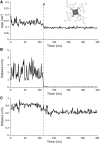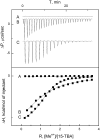Cation binding to 15-TBA quadruplex DNA is a multiple-pathway cation-dependent process
- PMID: 21893589
- PMCID: PMC3239185
- DOI: 10.1093/nar/gkr639
Cation binding to 15-TBA quadruplex DNA is a multiple-pathway cation-dependent process
Abstract
A combination of explicit solvent molecular dynamics simulation (30 simulations reaching 4 µs in total), hybrid quantum mechanics/molecular mechanics approach and isothermal titration calorimetry was used to investigate the atomistic picture of ion binding to 15-mer thrombin-binding quadruplex DNA (G-DNA) aptamer. Binding of ions to G-DNA is complex multiple pathway process, which is strongly affected by the type of the cation. The individual ion-binding events are substantially modulated by the connecting loops of the aptamer, which play several roles. They stabilize the molecule during time periods when the bound ions are not present, they modulate the route of the ion into the stem and they also stabilize the internal ions by closing the gates through which the ions enter the quadruplex. Using our extensive simulations, we for the first time observed full spontaneous exchange of internal cation between quadruplex molecule and bulk solvent at atomistic resolution. The simulation suggests that expulsion of the internally bound ion is correlated with initial binding of the incoming ion. The incoming ion then readily replaces the bound ion while minimizing any destabilization of the solute molecule during the exchange.
© The Author(s) 2011. Published by Oxford University Press.
Figures









References
-
- Blackburn EH. Telomeres: no end in sight. Cell. 1994;77:621–623. - PubMed
-
- De Lange T. Telomere-related genome instability in cancer. Cold Spring Harb. Symp. Quant. Biol. 2005;70:197–204. - PubMed
-
- De Cian A, Lacroix L, Douarre C, Temime-Smaali N, Trentesaux C, Riou J-F, Mergny J-L. Targeting telomeres and telomerase. Biochimie. 2008;90:131–155. - PubMed
-
- Sen D, Gilbert W. Formation of parallel four-stranded complexes by guanine-rich motifs in DNA and its implications for meiosis. Nature. 1988;334:364–366. - PubMed
Publication types
MeSH terms
Substances
LinkOut - more resources
Full Text Sources
Miscellaneous

